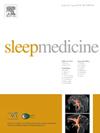Determinants of substance use patterns in patients with narcolepsy type 1: A multi-center comparative cross-sectional study
IF 3.8
2区 医学
Q1 CLINICAL NEUROLOGY
引用次数: 0
Abstract
Objectives
In this multi-center cross-sectional study, we compared substance use patterns (SUPs) between patients with narcolepsy type 1 (NT1) and controls, and investigated, among patients, factors associated with the consumption of the main psychoactive substances.
Methods
Adult patients with NT1 and controls completed questionnaires about tobacco, alcohol, and cannabis use patterns. Unadjusted bivariable then multivariate analyses (adjusted for sex, age, education, family status, and depression) were performed to compare SUPs between controls and patients, and to explore socio-demographic, psycho-behavioral, and clinical determinants of consumptions.
Results
We included 235 patients (63.8 % women, 36.4 ± 14.7 years) and 166 controls (69.9 % women, 40.3 ± 14.4 years). Substances co-consumptions were frequent in both groups. Patients with NT1 were more frequently current smokers (32.3 % vs. 20.1 %, p < 0.01) or e-cigarettes users (12.1 % vs 2.4 %, p < 0.001) than controls, while no difference was observed for cannabis use and alcohol misuse. Only the increased likelihood of vaping remained significant in adjusted analysis. Among NT1 patients, smoking was associated with disrupted nighttime sleep (OR[95%CI] = 2.28[1.02–5.12], p < 0.05) and less obesity (OR = 0.24[0.09–0.59], p < 0.05). Alcohol misuse was associated with sleep paralysis (OR = 2.11[1.13–3.91], p < 0.05) and treatments (modafinil: OR = 2.14[1.15–4.01], p < 0.05; sodium oxybate: OR = 0.41[0.17–0.97], p < 0.05). Tobacco and cannabis consumptions were associated with lower physical activity (OR = 0.46 [0.24–0.87], p < 0.05 and OR = 0.25[0.10–0.66], p < 0.01). Alcohol misuse and cannabis use were associated with rule breaking behaviors (OR = 5.89[1.61–21.60], p < 0.05 and OR = 8.52[1.79–40.48], p = 0.01).
Conclusion
Patients with NT1 do not seem less vulnerable to psychoactive substance use/misuse. Consumptions patterns are associated with multiple dimensions of the disease including sleep-related symptoms, comorbidities, treatments, and psycho-behavioral factors.

求助全文
约1分钟内获得全文
求助全文
来源期刊

Sleep medicine
医学-临床神经学
CiteScore
8.40
自引率
6.20%
发文量
1060
审稿时长
49 days
期刊介绍:
Sleep Medicine aims to be a journal no one involved in clinical sleep medicine can do without.
A journal primarily focussing on the human aspects of sleep, integrating the various disciplines that are involved in sleep medicine: neurology, clinical neurophysiology, internal medicine (particularly pulmonology and cardiology), psychology, psychiatry, sleep technology, pediatrics, neurosurgery, otorhinolaryngology, and dentistry.
The journal publishes the following types of articles: Reviews (also intended as a way to bridge the gap between basic sleep research and clinical relevance); Original Research Articles; Full-length articles; Brief communications; Controversies; Case reports; Letters to the Editor; Journal search and commentaries; Book reviews; Meeting announcements; Listing of relevant organisations plus web sites.
 求助内容:
求助内容: 应助结果提醒方式:
应助结果提醒方式:


